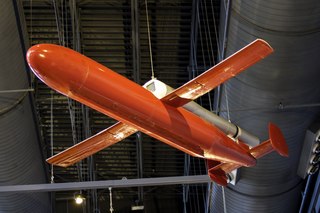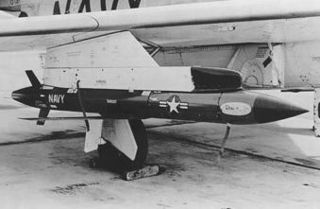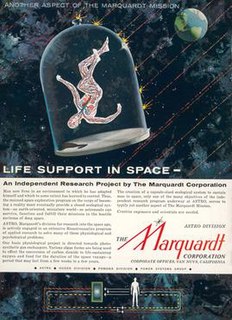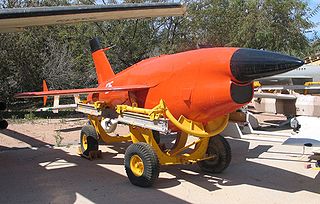
The BQM-74 Chukar is a series of aerial target drones produced by Northrop. The Chukar has gone through three major revisions, including the initial MQM-74A Chukar I, the MQM-74C Chukar II, and the BQM-74C Chukar III. They are recoverable, remote controlled, subsonic aerial target, capable of speeds up to Mach 0.86 and altitudes from 30 to 40,000 ft.

The Bristol Thor, latterly Bristol Siddeley BS.1009 Thor, was a 16-inch diameter ramjet engine developed by Bristol Aero Engines for the Bristol Bloodhound anti-aircraft missile.

The Lavochkin La-17 was the first Soviet unmanned aerial vehicle (UAV) to reach operational service. The first versions were developed in the early 1950s, and remained in service into the 1980s.

The AQM-60 Kingfisher, originally designated XQ-5, was a target drone version of the USAF's X-7 test aircraft built by the Lockheed Corporation. The aircraft was designed by Kelly Johnson, the designer who later went on to create the Lockheed A-12 and its relatives, such as the Lockheed SR-71 Blackbird and Lockheed YF-12.
The Marquardt RJ43-MA were ramjet engines used on the CIM-10 Bomarc missile, the D-21 drone, and the AQM-60. They were engineered and built by the Marquardt Corporation.

The MA-31 was a conversion of the Kh-31 anti-ship missile, developed by the Soviet Union during the 1980s, for use as a target drone by the United States Navy. Although the missile proved successful in this role, political complications resulted in the type being only an interim solution, and only a small number of the missiles were acquired.

The Microturbo TRI 60 is a small, expendable turbojet engine developed for use in cruise missiles, target drones, and other small unmanned air vehicles. Variants of this engine produce from 3.5 - 5.3 kN of thrust. The engine first ran in 1974.

The MQM-107 Streaker is a reusable, turbojet powered, target towing drone primarily used by the United States Army and the United States Air Force for testing and training. The US Army uses the drone for testing various surface-to-air missile systems such as the FIM-92 Stinger and the MIM-104 Patriot. The USAF uses them in practice engagements for their air-to-air missiles like the AIM-9 Sidewinder and the AIM-120 AMRAAM.

The Teledyne CAE J402 is a small turbojet engine. Several variants have been developed to power unmanned air vehicles such as missiles and target drones. Developed in the 1970s for the Harpoon anti-ship missile, the J402 was the first jet engine to be designed as a "wooden round", meaning that the engine had to be able to sit for long periods without maintenance or inspection and work right away.

The Advanced Strategic Air-Launched Missile (ASALM) was a medium-range strategic missile program, developed in the late 1970s for the United States Air Force. Intended for use in both the air-to-surface and anti-AWACS roles, the missile's development reached the stage of propulsion-system tests before being cancelled in 1980.

The Globe KD5G is a pulsejet-powered American target drone produced by Globe Aircraft Corporation that began development in 1949. Due to changing requirements for drone performance, it was only operated by the United States Navy for a short period.

The AQM-127 Supersonic Low-Altitude Target (SLAT) was a target drone developed during the 1980s by Martin Marietta for use by the United States Navy. Derived from Martin Marietta's work on the cancelled ASALM missile, SLAT proved to have severe difficulties in flight testing, and the project was cancelled during 1991.

The XBQM-108A was an experimental VTOL unmanned aerial vehicle developed by the United States Navy during the 1970s. Although the XBQM-108A successfully conducted tethered flight tests, the project was cancelled before any free flights could be conducted.

The Creative Research On Weapons or Crow program was an experimental missile project developed by the United States Navy's Naval Air Missile Test Center during the late 1950s. Intended to evaluate the solid-fueled integral rocket/ramjet (SFIRR) method of propulsion as well as solid-fueled ramjet engines, flight tests were conducted during the early 1960s with mixed success.

The Temco XKDT Teal was an American rocket-propelled, high-performance target drone, built by Temco Aircraft for evaluation by the United States Navy in the late 1950s. Production was not proceeded with following evaluation of the type.
The Nord CT.41 Narwhal was a French target drone, designed and built by Nord Aviation during the late 1950s for the purpose of providing training in the interception of supersonic bomber aircraft.
The Aerojet SD-2 Overseer was an unmanned aerial vehicle developed by Aerojet General and Rheem Manufacturing Co. in the late 1950s for use by the United States Army. Built in limited numbers, it never saw operational service.

The PTV-N-2 Gorgon IV was a ramjet-powered missile developed by the Glenn L. Martin Company for the United States Navy. Originally intended as an air-to-surface weapon, it materialized as a propulsion test vehicle, and between 1947 and 1950 was used for test purposes and, as the KDM Plover, as a target drone.




















